Dynamic Simulation of a CPV/T System Using the Finite Element Method
Abstract
:1. Introduction
2. CPV/T System Description
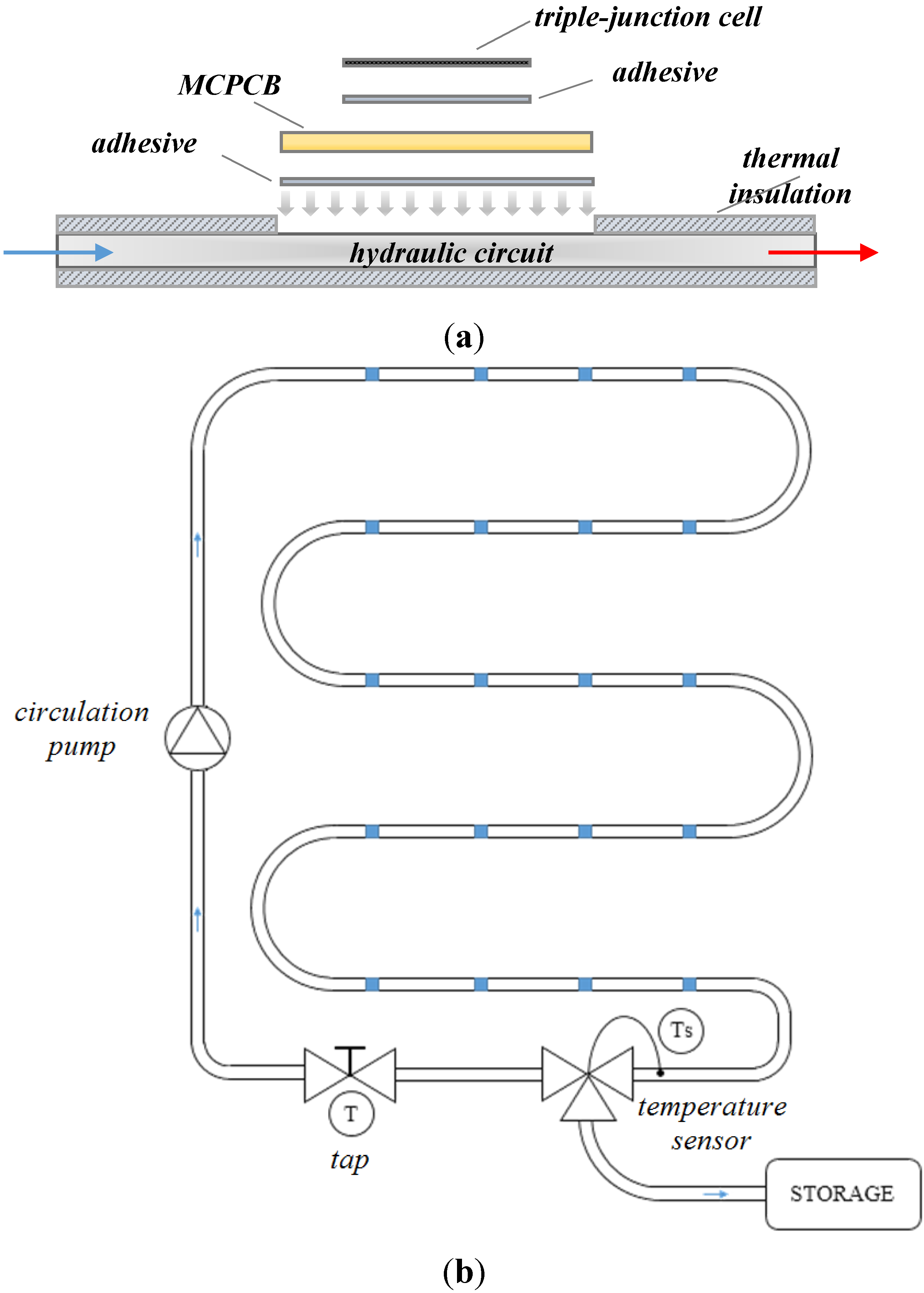
3. CPV/T System Dynamic Model
3.1. Solar Radiation
| Parameter | Symbol | Formula |
|---|---|---|
| Solar Declination | δ | |
| Local Solar Time Meridian | LSTM | (for Italy ) |
| Time Correction Factor | ΔT | |
| Equation of Time | EoT | |
| EoT Factor | B | |
| Local Time | LT | - |
| Local Solar Time | LST | |
| Solar Hour Angle | ω | |
| Solar Altitude | α | |
| Zenith Angle | ϑz | |
| Solar Azimuth | γ |
| Symbol | Formula |
|---|---|
| n | |
| Xmax | |
| A |
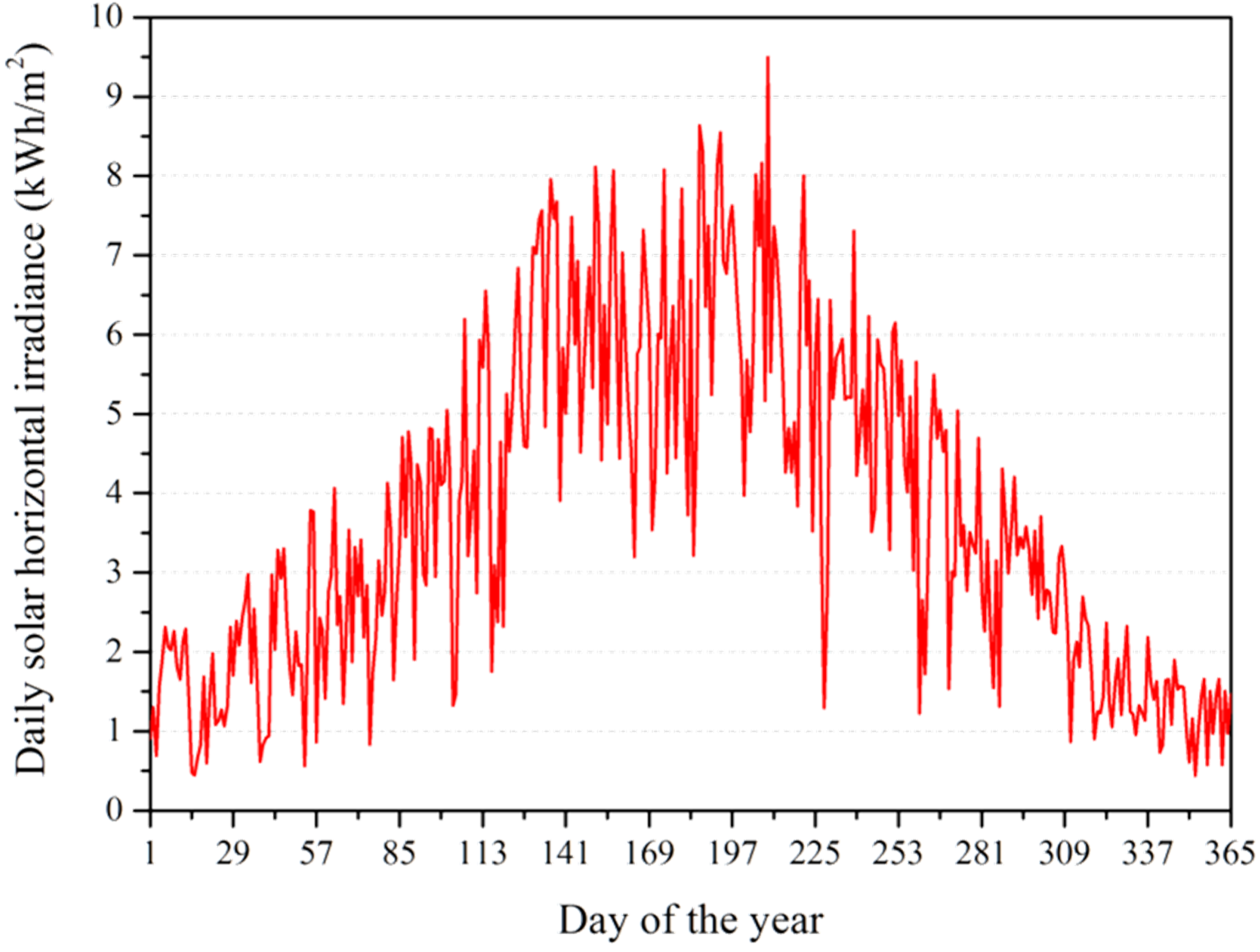
| Location | Solar atlas [19] | CM-SAF [20] | Model |
|---|---|---|---|
| Bari (41.1°N–16.9°E) | 1625–1700 kWh/m2 | 1680 kWh/m2 | 1745 kWh/m2 |
| Catania (37.5°N–15.1°E) | 1775–1850 kWh/m2 | 1830 kWh/m2 | 1780 kWh/m2 |
| Florence (43.8°N–11.2°E) | 1475–1550 kWh/m2 | 1500 kWh/m2 | 1560 kWh/m2 |
| Genova (44.4°N–9.0°E) | 1400–1475 kWh/m2 | 1475 kWh/m2 | 1495 kWh/m2 |
| Milan (45.5°N–9.2°E) | 1325–1400 kWh/m2 | 1450 kWh/m2 | 1395 kWh/m2 |
| Naples (41.1°N–14.3°E) | 1625–1700 kWh/m2 | 1690 kWh/m2 | 1665 kWh/m2 |
| Palermo (38.1°N–13.4°E) | 1700–1775 kWh/m2 | 1790 kWh/m2 | 1740 kWh/m2 |
| Rome (41.9°N–12.5°E) | 1550–1625 kWh/m2 | 1670 kWh/m2 | 1625 kWh/m2 |
| Turin (45.1°N–7.7°E) | 1400–1475 kWh/m2 | 1460 kWh/m2 | 1425 kWh/m2 |
3.2. Solar Cell Electric Model
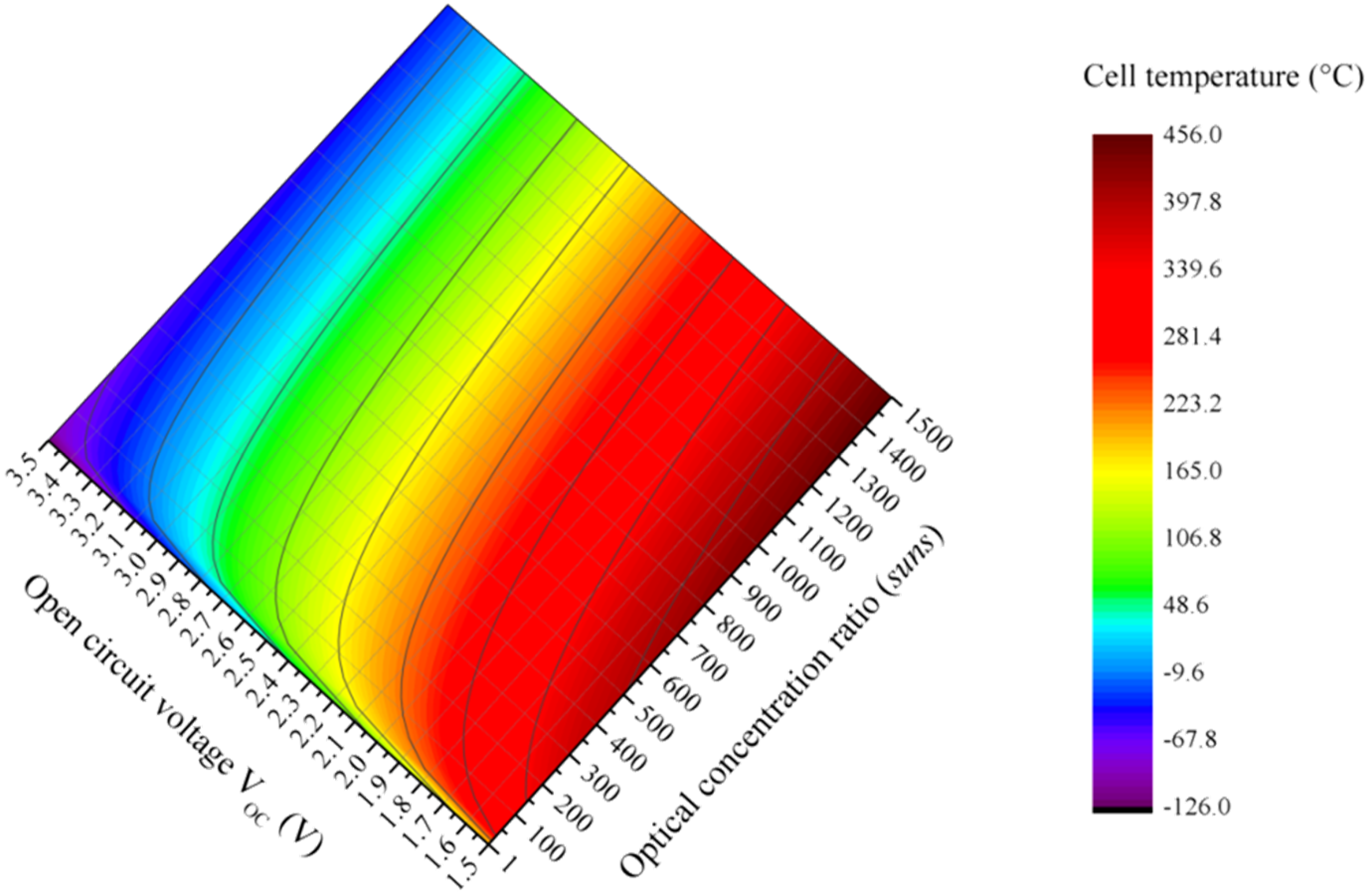
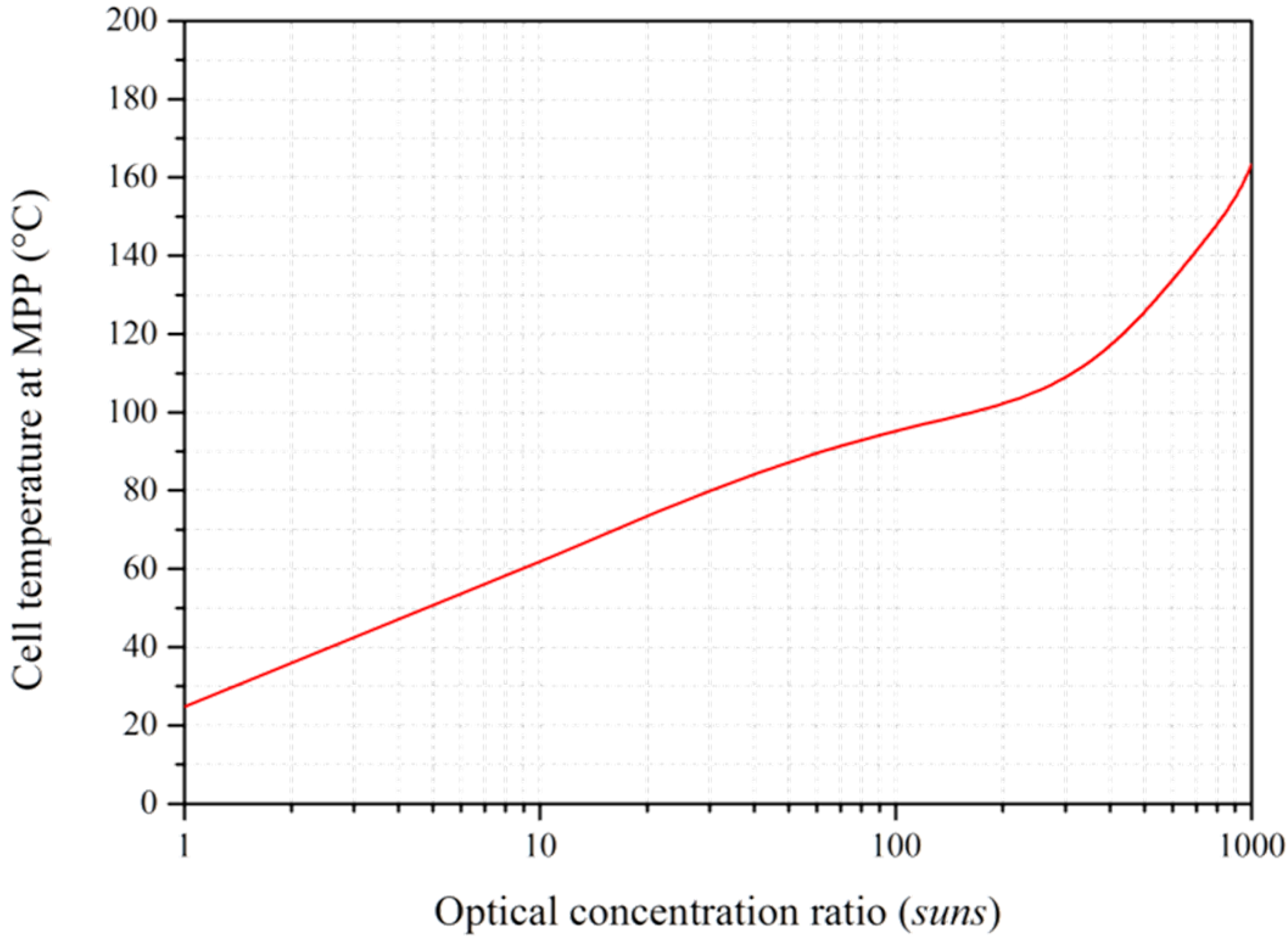
3.3. Cell Efficiency
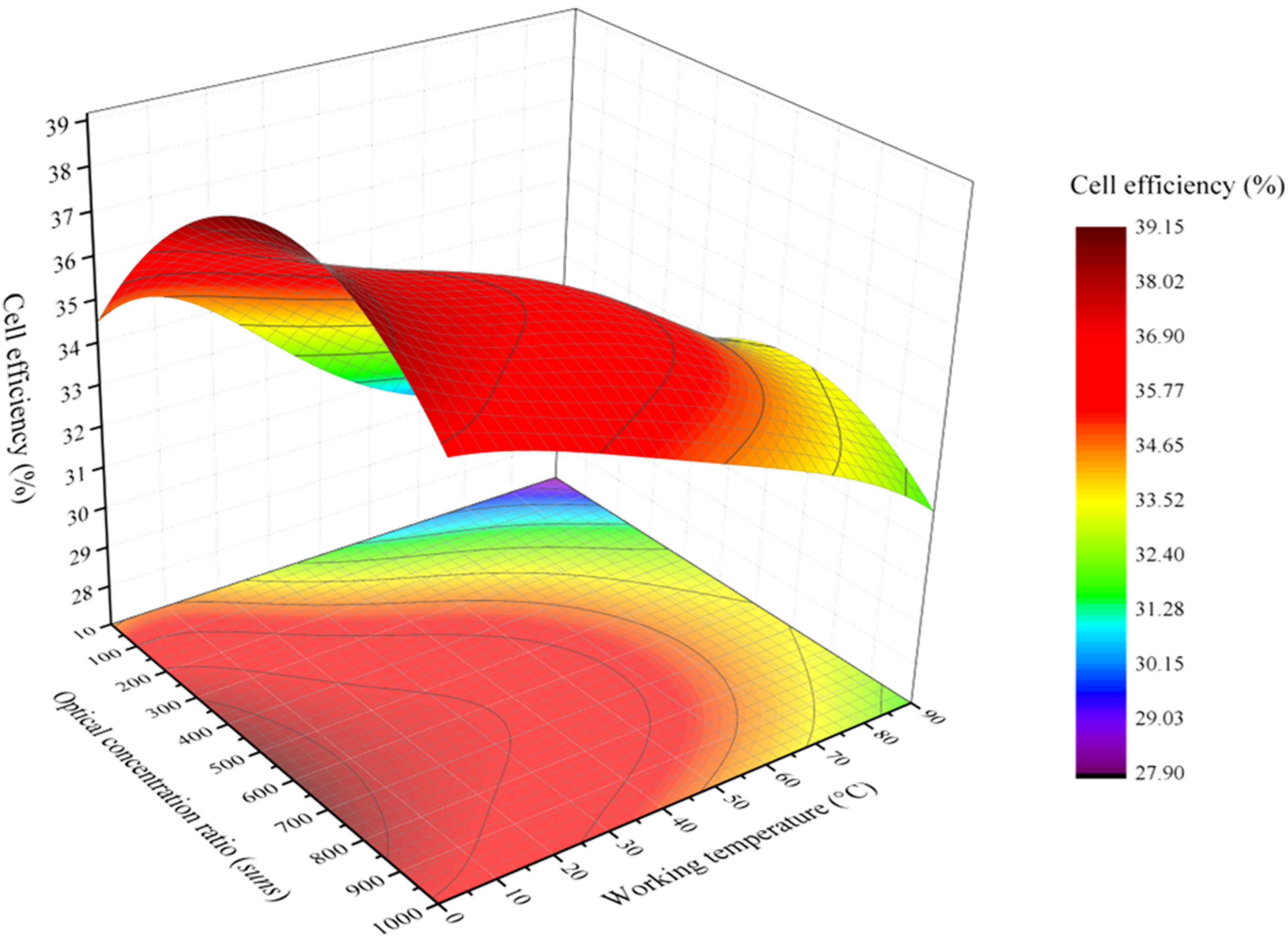
3.4. Electric and Thermal Power
| System | Output power | Model | Δ |
|---|---|---|---|
| ArimaEco CPV G1 [a] | 621 Wp | 613.5 Wp | −1.2% |
| Meridian MGM16-96 [b] | 96 Wp | 97.9 Wp | +2.0% |
| Emcore G3-1090x [c] | 455 Wp | 457.8 Wp | +0.6% |
| GPW HCPV [d] | 400 Wp | 396.8 Wp | −0.8% |
| Mini Dish CPV [26] | 172 Wp | 171.3 Wp | −0.4% |
| Mini Dish CPV [26] | 530 Wth | 522.9 Wth | −1.3% |
3.5. CPV/T System FEM Analysis
4. Energy and Economic Analysis
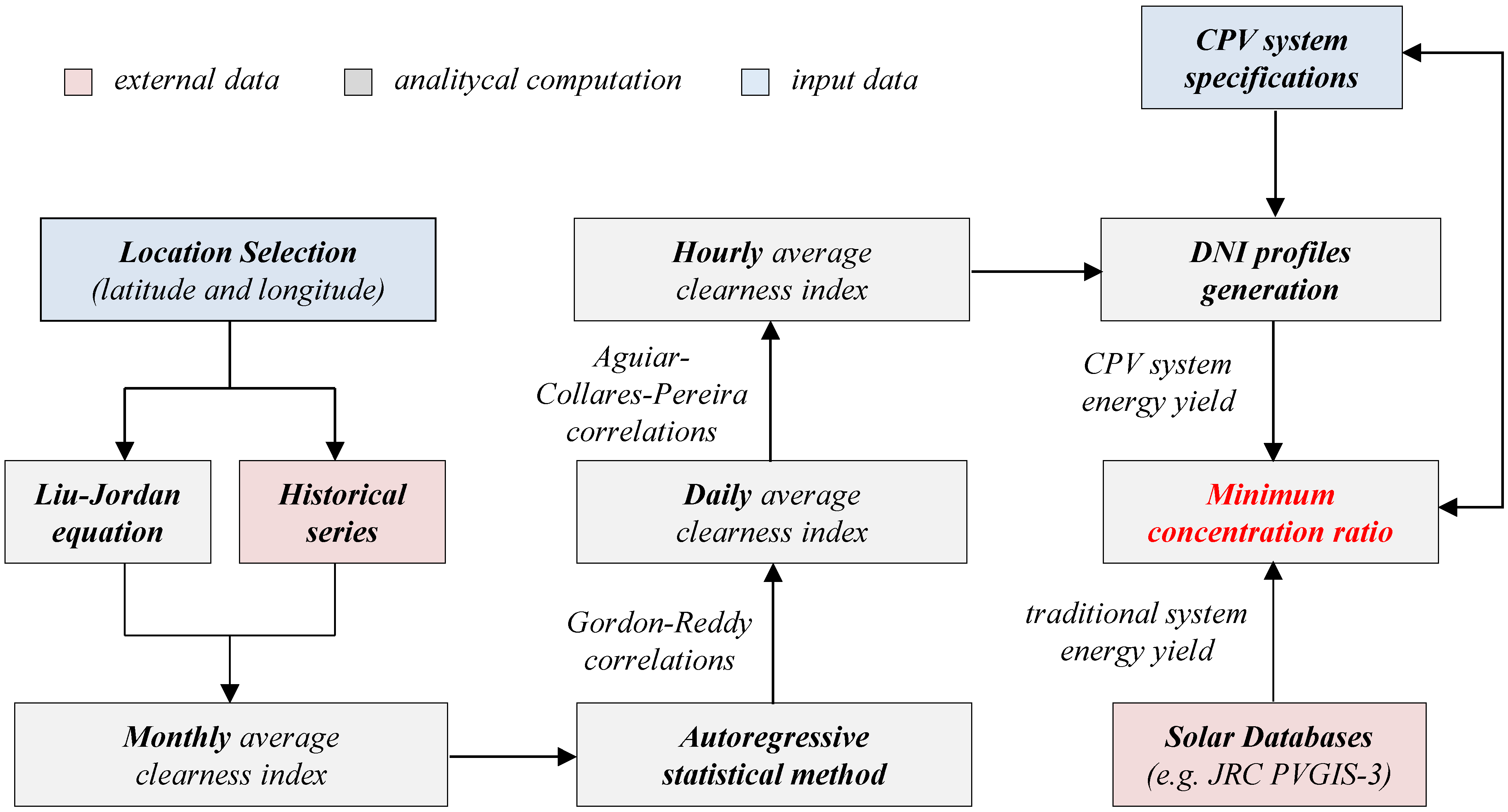
5. Results and Discussion
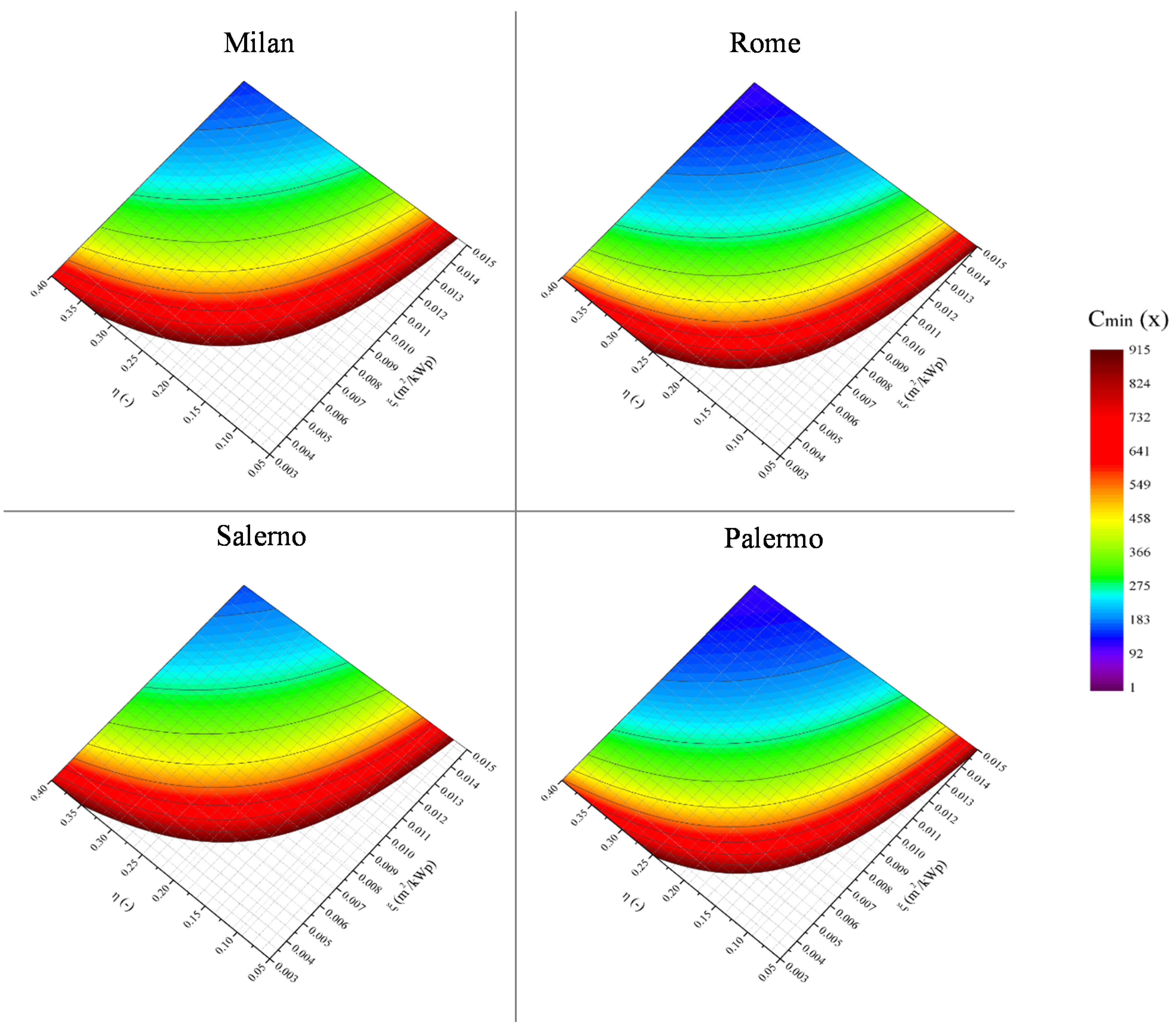
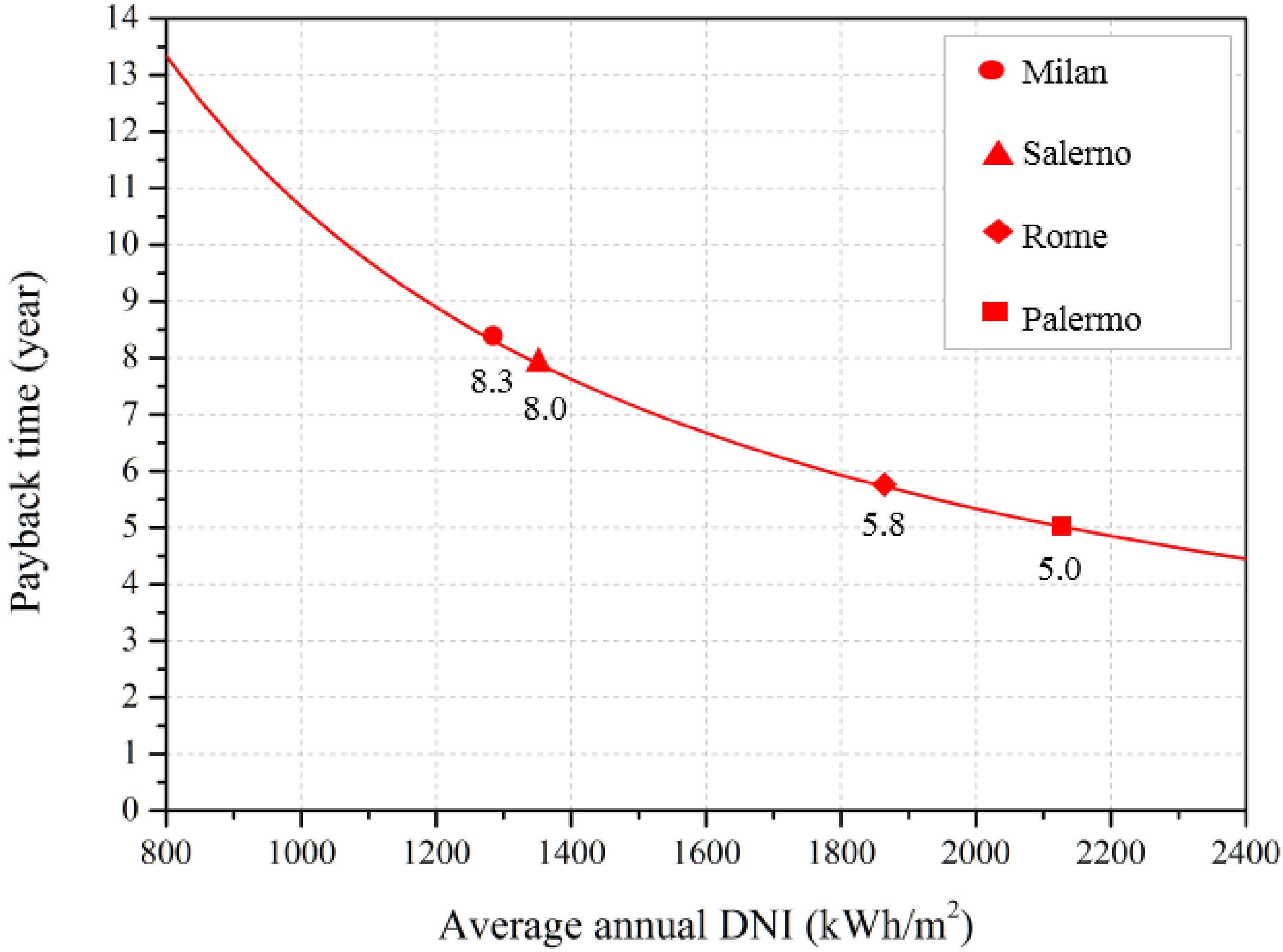

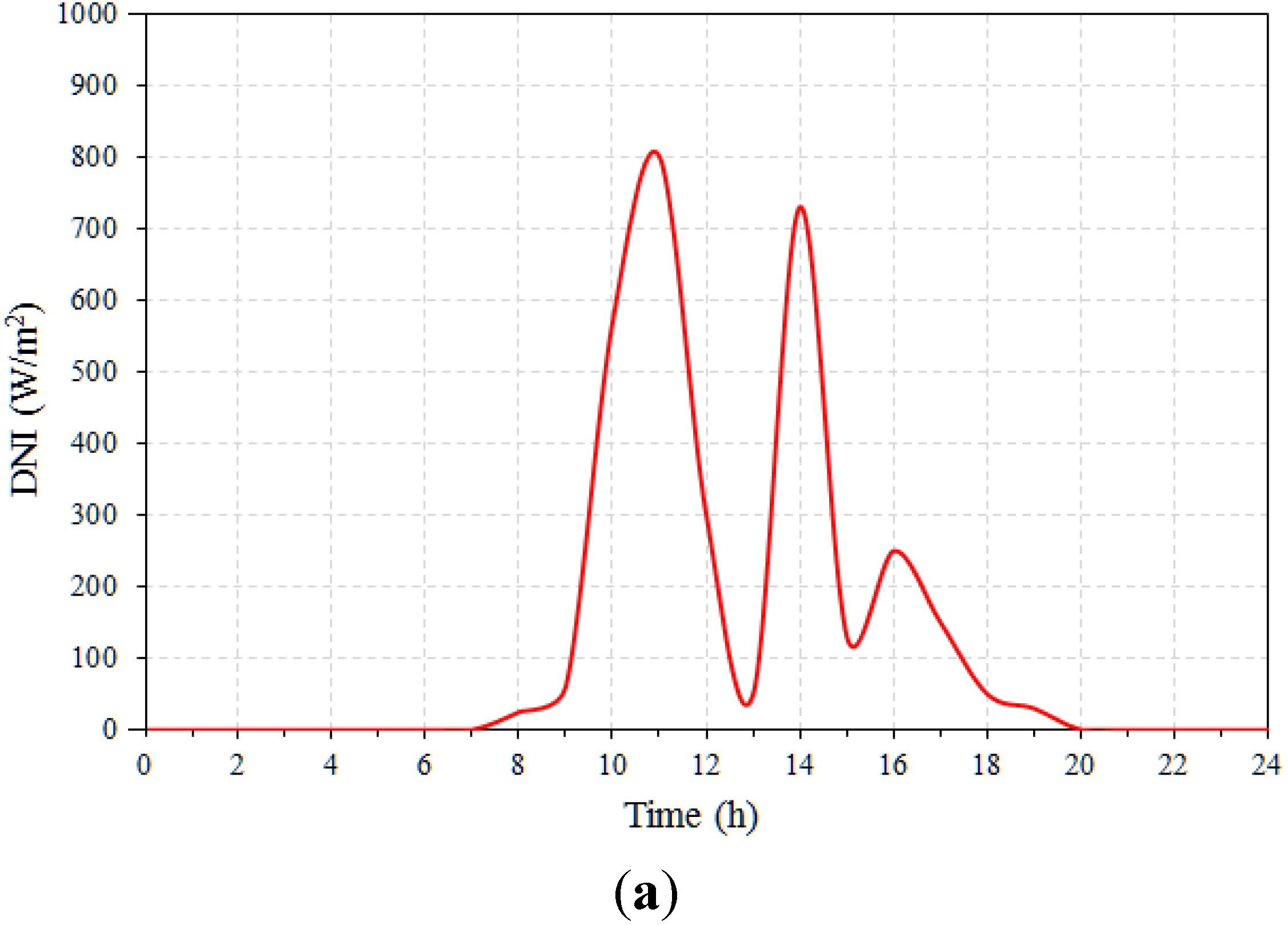
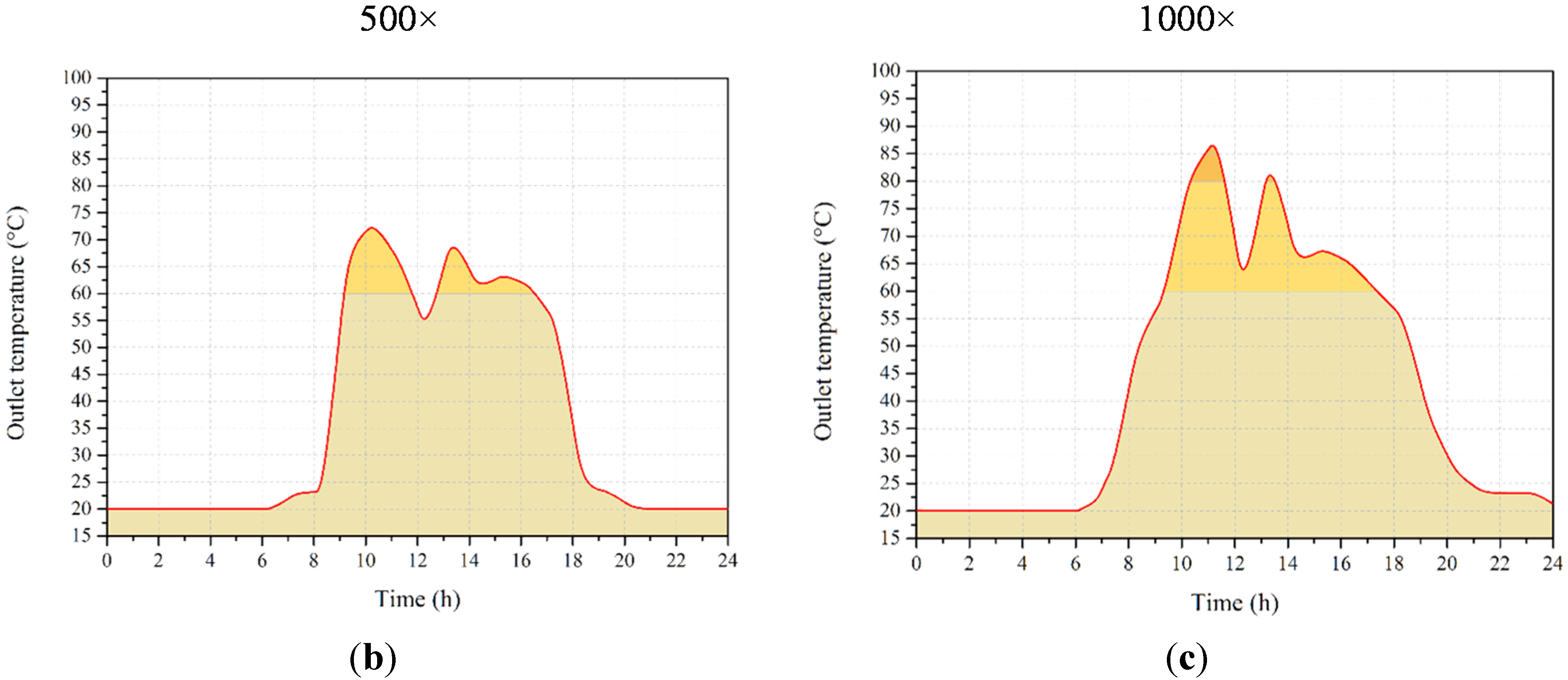
6. Conclusions
Author Contributions
Nomenclature
| BOS | Balance of System |
| C | optical concentration ratio (suns) |
| CFD | Computational Fluid Dynamics |
| CPV | Concentrating PhotoVoltaic |
| CPV/T | Concentrating PhotoVoltaic/Thermal |
| Cx | geometric concentration ratio (x) |
| DNI | Direct Normal Irradiance (W/m2) |
| E | energetic yield per power unit (kWh/kWp) |
| FEM | Finite Element Method |
| G | solar irradiance (W/m2) |
| H | solar insolation (Wh/m2) |
| HCPV | High Concentrating PhotoVoltaic |
| I | current intensity (A) |
| ktd | daily clearness index (-) |
| kth | hourly clearness index (-) |
| ktm | monthly clearness index (-) |
| MCPCB | Metal Core Printed Circuit Board |
| MPP | Maximum Power Point |
| P | power (W) |
| p | pressure (atm) |
| po | standard pressure (1 atm) |
| STC | Standard Test Condition (25 °C, 1 atm, 1000 W/m2) |
| T | absolute temperature (K) |
| t | time (s) |
| V | electric voltage (V) |
Greek Symbols
| α | solar altitude (°) |
| β | module tilt angle (°) |
| γ | solar azimuth (°) |
| γs | system azimuth (°) |
| δ | solar declination (°) |
| η | efficiency (-) |
| ϑz | solar zenith (°) |
| ξ | active surface per power unit (m2/ kWp) |
| φ | latitude (°) |
| ω | solar hour angle (°) |
| ωs | sunset hour angle (°) |
Subscripts
| c | cell |
| dif | diffuse |
| dir | direct |
| el | electric |
| ext | extraterrestrial |
| h | horizontal |
| inv | inverter |
| max | maximum |
| min | minimum |
| mod | module |
| OC | open circuit |
| opt | optics |
| p | peak |
| r | reference condition |
| ref | reflected |
| s | series |
| SC | short circuit |
| sh | shunt |
| th | thermal |
| tot | total |
| tr | tracking system |
| TRD | traditional |
| w | working condition |
Conflicts of Interest
References
- Zahedi, A. Review of modeling details in relation to low-concentration solar concentrating photovoltaic. Renew. Sustain. Energy Rev. 2011, 15, 1609–1614. [Google Scholar] [CrossRef]
- Chemisana, D. Building integrated concentrating photovoltaics: A review. Renew. Sustain. Energy Rev. 2010, 15, 603–611. [Google Scholar] [CrossRef]
- Cotal, H.; Fetzer, C.; Boisvert, J.; Kinsey, G.; King, R.; Hebert, P.; Yoon, H.; Karam, N. III–V multi-junction solar cells for concentrating photovoltaics. Energy Environ. Sci. 2009, 2, 174–192. [Google Scholar] [CrossRef]
- Li, M.; Ji, X.; Li, G.; Wei, S.; Li, Y.; Shi, F. Performance study of solar cell arrays based on a Trough Concentrating Photovoltaic/Thermal system. Appl. Energy 2011, 88, 3218–3227. [Google Scholar] [CrossRef]
- Mittelman, G.; Kribus, A.; Dayan, A. Solar cooling with concentrating photovoltaic/thermal (CPVT) systems. Energy Convers. Manag. 2007, 48, 2481–2490. [Google Scholar] [CrossRef]
- Kandilli, C. Performance analysis of a novel concentrating photovoltaic combined system. Energy Convers. Manag. 2013, 67, 186–196. [Google Scholar] [CrossRef]
- Li, M.; Li, G.L.; Ji, X.; Yin, F.; Xua, L. The performance analysis of the trough concentrating solar photovoltaic/thermal system. Energy Convers. Manag. 2011, 52, 2378–2383. [Google Scholar] [CrossRef]
- Kosmadakis, G.; Manolakos, D.; Papadakis, G. Simulation and economic analysis of a CPV/thermal system coupled with an organic Rankine cycle for increased power generation. Sol. Energy 2011, 85, 308–324. [Google Scholar] [CrossRef]
- Al-Alili, A.; Hwang, Y.; Radermacher, R.; Kubo, I. A high efficiency solar air conditioner using concentrating photovoltaic/thermal collectors. Appl. Energy 2012, 93, 138–147. [Google Scholar] [CrossRef]
- Renno, C.; Petito, F. Design and modeling of a concentrating photovoltaic thermal (CPV/T) system for a domestic application. Energy Build. 2013, 62, 392–402. [Google Scholar] [CrossRef]
- Renno, C. Optimization of a concentrating photovoltaic thermal (CPV/T) system used for a domestic application. Appl. Therm. Eng. 2014, 67, 396–408. [Google Scholar] [CrossRef]
- Honsberg, C.; Bowden, S. PVEducation.org-PVCDROM. Available online: http://www.pveducation.org/ (accessed on 9 June 2014).
- Duffie, J.A.; Beckmann, W. Solar Engineering of Thermal Processes; John Wiley & Sons: New York, NY, USA, 2006. [Google Scholar]
- Owen, M.S. ASHRAE Handbook: HVAC Applications; ASHRAE: Atlanta, GA, USA, 2011. [Google Scholar]
- Eicker, U. Solar Technologies for Buildings; John Wiley & Sons: New York, NY, USA, 2003. [Google Scholar]
- Gordon, J.M.; Reddy, T.A. Time series analysis of daily horizontal solar radiation. Sol. Energy 1988, 41, 215–226. [Google Scholar] [CrossRef]
- Heating and Cooling of Buildings. Climatic Data; UNI 10349, UNI Italian Company: Milan, Italy, 1994.
- Liu, B.Y.H.; Jordan, R.C. The interrelationship and characteristic distribution of direct, diffuse and total solar radiation. Sol. Energy 1960, 4, 1–19. [Google Scholar] [CrossRef]
- SolarGIS. Available online: http://solargis.info/doc/free-solar-radiation-maps-GHI (accessed on 20 June 2014).
- Photovoltaic Geographical Information System (PVGIS). Available online: http://re.jrc.ec.europa.eu/pvgis/ (accessed on 25 June 2014).
- Aguiar, R.; Collares-Pereira, M. TAG: A time-dependent, autoregressive, Gaussian model for generating synthetic hourly radiation. Sol. Energy 1992, 49, 167–174. [Google Scholar] [CrossRef]
- Erbs, D.G.; Klein, S.A.; Duffie, J.A. Estimation of the diffuse radiation fraction for hourly, daily and monthly-average global radiation. Sol. Energy 1982, 28, 293–302. [Google Scholar] [CrossRef]
- King, R.R.; Law, D.C.; Edmondson, K.M.; Fetzer, C.M.; Kinsey, G.S.; Yoon, H.; Sherif, R.A.; Karam, N.H. 40%-efficient metamorphic GaInP/GaInAs/Ge multi-junction solar cells. Appl. Phys. Lett. 2007, 90, 183516. [Google Scholar] [CrossRef]
- Ju, X.; Vossier, A.; Wang, Z.; Dollet, A.; Flamant, G. An improved temperature estimation method for solar cells operating at high concentrations. Sol. Energy 2013, 93, 80–89. [Google Scholar] [CrossRef]
- Mousazadeh, H.; Keyhani, A.; Javadi, A.; Mobli, H.; Abrinia, K.; Sharifi, A. A review of principle and sun-tracking methods for maximizing solar systems output. Renew. Sustain. Energy Rev. 2009, 13, 1800–1818. [Google Scholar] [CrossRef]
- Kribus, A.; Kaftori, D.; Mittelman, G.; Hirshfeld, A.; Flitsanov, Y.; Dayan, A. A miniature concentrating photovoltaic and thermal system. Energy Convers. Manag. 2006, 47, 3582–3590. [Google Scholar] [CrossRef]
- King, R.R.; Bhusari, D.; Larrabee, D.; Liu, X.Q.; Rehder, E.; Edmondson, K.; Cotal, H.; Jones, R.K.; Ermer, J.H.; Fetzer, C.M.; et al. Solar cell generations over 40% efficiency, 26th EU PVSEC, Hamburg, Germany, 2011. Prog. Photovolt. 2012, 20, 801–815. [Google Scholar] [CrossRef]
- Mastrullo, R.; Renno, C. A thermoeconomic model of a photovoltaic heat pump. Appl. Therm. Eng. 2010, 30, 1959–1966. [Google Scholar] [CrossRef]
- Gómez-Gil, F.J.; Wang, X.; Barnett, A. Analysis and prediction of energy production in concentrating photovoltaic (CPV) installations. Energies 2012, 5, 770–789. [Google Scholar] [CrossRef]
© 2014 by the authors; licensee MDPI, Basel, Switzerland. This article is an open access article distributed under the terms and conditions of the Creative Commons Attribution license (http://creativecommons.org/licenses/by/4.0/).
Share and Cite
Renno, C.; De Giacomo, M. Dynamic Simulation of a CPV/T System Using the Finite Element Method. Energies 2014, 7, 7395-7414. https://doi.org/10.3390/en7117395
Renno C, De Giacomo M. Dynamic Simulation of a CPV/T System Using the Finite Element Method. Energies. 2014; 7(11):7395-7414. https://doi.org/10.3390/en7117395
Chicago/Turabian StyleRenno, Carlo, and Michele De Giacomo. 2014. "Dynamic Simulation of a CPV/T System Using the Finite Element Method" Energies 7, no. 11: 7395-7414. https://doi.org/10.3390/en7117395
APA StyleRenno, C., & De Giacomo, M. (2014). Dynamic Simulation of a CPV/T System Using the Finite Element Method. Energies, 7(11), 7395-7414. https://doi.org/10.3390/en7117395






